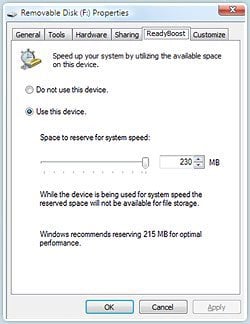The first answer is SuperFetch, which works with ReadyBoost to identify your storage device. Readyboost assigns your flash device as a makeshift RAM component then Superfetch stores pre-fetch data from commonly used applications into the device thus reducing load times. Flash devices, although having slower read and write times, have faster random seek times than a Hard drive so this allows commonly used program data to be called as if it were on speed-dial. (groovy eh ;) ) ReadyBoost is particularly useful on laptops which tend to have higher prices for RAM. There are also reports that ReadyBoost can improve laptop battery life by minimizing the need your Hard drive has to be accessed. The fewer times your drive is accessed, the fewer times the Hard drive has to “spin-up.” Net result = less power consumption – and that’s a good thing. So how do I get it to work? Well, Vista has made it easy! There are just a few requirements:
The device must have a minimum capacity of 256 MB.The device must have at least 235 MB of free space.
Just Plug in your Flash storage device, then Vista will prompt you with an autoplay menu; Select the “Speed up my drive” option
All done! Now just leave the device plugged in, and you’re ready to go. Enjoy load times up to 4 times faster, and less lag while performing background tasks like anti-virus updates. The only not-so-groovy news about ReadyBoost is, Virtual PC 2007 doesn’t have support for local USB devices as of yet. However, Microsoft is planning to allow Readyboost to access hard drives across a network for virtual ram storage. This access may allow for networked USB devices through Virtual PC in the future. Also note that no matter the size of your device capacity, ReadyBoost will only utilize up to the first 4 gigabytes of space, so don’t go out buying huge flash drives just for ReadyBoost! Wasn’t aware of it until someone pointed out the feature to me! Too bad the system can’t use more than 4Gb of the USB’s memory stick (esp. if you own the 8gb sticks)!! At least it “should” provide “some” performance improvement! What email program? I’m assuming Outlook, and if that is the case cleaning out your PST files can help with performance. But most likely a new computer is going to be bloated with tons of crapware and trial software that Dell / HP gets paid to include when they send you the PC. It sucks they do that but it makes sense from a business stand-point. Comment Name * Email *
Δ Save my name and email and send me emails as new comments are made to this post.


